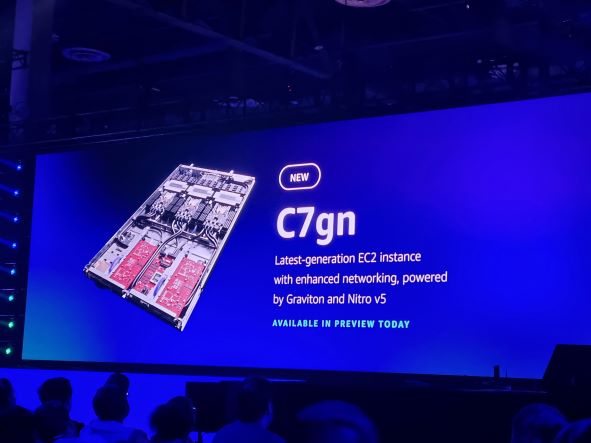Walk up the Las Vegas strip in the dusk and nearly everyone is wearing a re:Invent 2022 lanyard. Step inside the Venetian casino and hotel – the primary venue for the annual Amazon Web Services (AWS) conference, which is back in person for the first time in three years – and an ambience familiar to regular attendees awaits.
There’s the cigarette smoke wafting off the casinos; the thumping house music; the clamour of sponsors competing for attention span with swag, neon, breakout sessions and expert advice; or at least opinions.
AWS is a behemoth. It serves automakers, intelligence agencies, pharmaceutical firms, multinational banks, governments and more with compute, storage and networking, adding sophisticated new capabilities at a dizzying pace. (AWS released 2,757 new “significant services and features” in 2020, and 3,084 in 2021 alone.)
It's scale always shows at re:Invent and 2022 is no different, wtih ~50,000 people from around the world descending for the conference and other 300,000 tuning in digitally for streamed keynotes and roundtables.
In the Venetian’s main auditorium late on Monday several thousand delegates are soaked in Tech Conference Blue Lighting™ and pinned back in their seats by the decibels of a live rock band hammering out songs. They’re awaiting the inaugural re:Invent 2022 keynote speech; one that will be closely scrutinised by partners, rivals, and the customers that have powered AWS to an annual revenue run rate of $82 billion this year.
The clock hits 19:30, the band scampers off stage and AWS’s Peter DeSantis – a Senior Vice President (SVP) who has been described as AWS’s “infrastructure czar” – steps onto it, smiling, sweating slightly.
He wants to talk about the “p” word.
Some backdrop
As economic headwinds blow many customers are reining in spending. (CFO Brian Olsavsky said during Amazon’s last earnings call that “customers are looking to save money versus their committed spend”).
“Elasticity”, “security”, “performance”, “cost”, “availability”, “sustainability” say the words on DeSantis's opening slide. Is he going to talk about cost? It’s been a growing concern for many CIOs that The Stack talks with: The “all in” euphoria of the earlier public cloud days has been outstripped in many quarters by some concern at lock-in risk and data egress fees and rivals have started to chip away at that as a perceived chink in AWS’s armour.
DeSantis has another word in mind to focus on, telling his audience: “You can rest assured that we remain committed to being meaningfully differentiated on these key attributes.
"Tonight, I want to focus on one of them in particular, ‘performance’”.
Over the course of a distinctly technical speech (“stochastic modelling”; “TCP over ENA Express”; “EFA, EBS, ENA”) he proceeds to hone in on the extensive work AWS has been doing on its own infrastructure and architecture, detailing some powerful new hardware and networking capabilities as a fresh deluge of updates lands.
If there’s a subtext to the acronym-heavy flurry of releases it is this: "We are investing heavily in innovation in a way that you cannot match on-premises; beware getting left behind." Amazon has, after all, committed to what its CFO described as a “$10 billion year-over-year increase in technology infrastructure, primarily to support the rapid growth, innovation and continued expansion of our AWS footprint” and tonight that firepower is on show.
So what’s new? Well, lots…
First up is “AWS Nitro v5”. That’s custom silicon (“50% faster DRAM speed, 2x more PCIe bandwidth, 40% better performance per watt, 30% lower latency”) built by Amazon’s own Annapurna labs for its Nitro hypervisor and which features double the number of transistors to the previous iteration of the Nitro chip.
There’s a new AWS instance type, C7gn powered by the Nitro v5 and then there’s a new version of its Graviton chips (“Graviton3E”) which was specifically designed for powering high-performance computing workloads including heavyweight financial options pricing (30% faster) for AWS’s many capital markets clients.

Then there’s SRD: That’s AWS rethought internal data centre networking protocol.
Get following The Stack on LinkedIn
Talking through that, DeSantis touts the general availability of Elastic Network Adapter (ENA) Express for Amazon EC2 instances. As he explains, all current generation EC2 instances (the bread and butter compute service of AWS) use ENA, a purpose-built network interface. ENA Express meanwhile is a new ENA feature that uses the AWS Scalable Reliable Datagram (SRD) protocol to improve network performance in two key ways: higher single flow bandwidth and lower tail latency for network traffic between EC2 instances.
ENA Express is pretty clever. Whilst some lowly mortals might use TCP as a data centre protocol, as AWS puts it, TCP is “not equipped to handle congestion when your server is overloaded with requests.”
The hyperscaler’s SRD is a proprietary protocol that delivers these improvements through “advanced congestion control, multi-pathing, and packet reordering directly from the Nitro card” and ENA Express, in turn, is a new option to let customers enable SRD with a “single command or console toggle” for their EC2 instances.
“Using the SRD protocol” says AWS, “ENA Express increases the maximum single flow bandwidth of EC2 instances from 5 Gbps up to 25 Gbps, and it can provide up to 85% improvement in P99.9 latency for high throughput workloads”. Detailed monitoring is available for these SRD connections through new ethtool metrics in the latest Amazon Linux AMI (a Linux execution environment for apps running on Amazon EC2.)
DeSantis is getting more willfully dense as the speech continues (“a more accurate title for what this keynote has pivoted into would have been "Monday Night Computer Science Lecture with Peter DeSantis” quips cloud economist Corey Quinn) and next up is AWS Lambda SnapStart, which can make Java functions “start up to 10x faster, at no extra cost” on AWS’s Lambda serverless platform. A digested version of this that when a function’s not used for a while Lambda will shut it down and restarting can be less snappy than many would like. SnapStart takes snapshots of a customer’s Lambda functions and uses those to make real improvements on the usual initialisation process (cold start duration has gone from over six seconds to less than 200 ms.)
Snap reactions
A quick voxpop of delegates slipping out of the speech early solicits mixed reactions from the bluntly honest: “That went way over my head”, to the cynical: “Just AWS selling its own hardware, I’m not here for that”, to the enthused: “AWS’s infrastructure is insane. I’m here to get the details and pass them onto our stakeholders and partners who can work out if they want to do something with it and what the performance benefits are.”)
A quick glimpse at AWS’s “what’s new” page meanwhile highlights that on Day 1 of re:Invent 2022 alone there’s been a host of other new releases, including the general availability of AWS Wickr. That’s an end-to-end encrypted, enterprise communications service built on Wickr (bought by Amazon June 2021) with “ advanced security features… facilitates one-to-one chats, group messaging, calling, file sharing, screen sharing, and more.”
AWS’s CEO is up for another keynote soon. There’s a lot more news pending. The Stack will be pulling out some highlights during the week, stay tuned, as well as interviewing partners, customers and others for a deeper dive and reflections once the flurry of press releases, speeches and breakout sessions has subsided.









